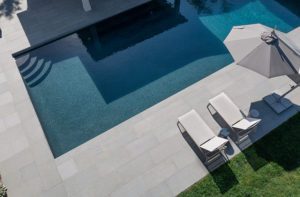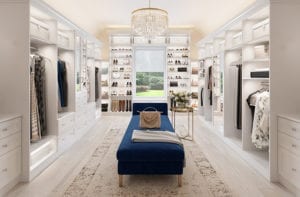In Her Nature
October 22, 2013
Text by Lisa E. Harrison
I’m poring over a book of images that Joan Backes has compiled of her work from 2004 through 2012. There are a hundred or so beautiful photos that capture the creations of the internationally renowned, Providence, Rhode Island–based, installation artist and painter. There are no captions, a tactic designed to allow the viewer’s mind to meander and process.
The photos of Backes’s art, like the art itself, are compelling: the life-size houses that beckon one to enter, the colorful cardboard trees that cast playful shadows, the paintings of bark that seem so textured they need to be touched to prove otherwise.
The page that makes me pause, however, doesn’t depict a finished product. It’s a trio of pictures showing an installation in progress of one of Backes’s signature houses. The top right photo shows the artist kneeling on the forest floor, deftly bisecting a felled tree with a chainsaw. Backes is all focus, just as she is in the image to the left where, hunched over the tree trunk and armed with a mallet and chisel, she cuts notches into the logs. Below, two assistants, their backs to the camera, survey the frames of the three houses, lying flat on the ground, that Backes will soon stand upright and allow to spring to three-dimensional life.
The series of photos documents the creation of Berliner Häuser, a 2011 installation fabricated from Douglas fir from—and set in—the Grünewald Forest in Berlin. It took five weeks to build the cluster of minimalist, open A-frame houses, a stripped-down version of Backes’s fanciful Brothers Grimm–inspired Forest House, a 2010 installation in Germany’s Odenwald Forest.
Berliner Häuser, which, over the fifteen or so years of its life, will blend into and age with its forest surroundings, demands interaction. Walk through the door frames, look up at the treetops through the open roof, peer through the wall lines at the companion houses. They blend outside and inside and simultaneously compress and expand notions of space and place, art and environment. They subtly raise questions about nature, about our ability to live in it and our capacity to alter it.
“My work has always been about nature,” says Backes. “Since I was a little girl this has been my focus; both parents emphasized nature, and I’m still inspired by it.”
Growing up in Milwaukee, she remembers flying kites with her father, collecting clay from a nearby creek bed, and watching her mother hang bird feeders, tend the garden, and plant trees.
Backes also credits her family for her interest in the iconic house form. “It may be subconsciously related to the fact that my paternal grandfather was an architect,” she says. But while an architect is focused on structure and function, Backes explores not only the notion of home, but also the intersection of nature, culture, and art. Since 2007, she has built some eighteen structures bestowed with literal monikers such as Cardboard House, Paper House, and Bamboo House. As their names suggest, their makeup varies, but they all provoke thought and stir the imagination.
Examination of the natural world is also the cornerstone of Backes’s paintings. Her Bark series, acrylic on archival panels, pays homage to the mighty tree by zeroing in on and exploring one section of bark. The realistic colors and textures and the almost three-dimensional preciseness of the paintings pull the viewer in. And therein lies a special treat: “They’re abstract when you get up close, but representative from afar,” the artist explains.
Backes’s work with trees is not limited to paintings. She has also crafted a series of graphic tree sculptures, including Multi-Species Tree, which is part of the permanent collection at the Racine Art Museum, in Wisconsin. It stands twelve feet high, measures ten feet around, and is made of recycled wood, once again creating a dialogue about our ever-evolving relationship with the natural world. The colorful leaves on Multi-Species Tree are acrylic and attached with wire, but Backes has spent a good deal of time working with the real thing, too. Her “carpets of leaves” comprise foliage she has collected in her travels, pressed, laminated, and arranged flat on the ground (one shown at New York City’s Chelsea Art Museum ran nineteen feet). “It’s becoming a world carpet,” she says of the leaves, which she stores and uses time and again.
Backes’s latest subject, pavement, deviates slightly—though not really, assures the artist. “It’s important to keep some semblance of the same subject matter,” she says. Backes explores the reality of the concrete jungle and the paving over of our natural resources in an ongoing series that documents urban areas, including Boston, Seattle, and New York City. Like the Bark series, these paintings zoom in to the pavement itself—and, simultaneously, the ecological implications the series implies.
Backes’s work is understated, yet powerful. “To me, it’s about beauty first,” she says. “I’m hoping that people come toward a piece and find something that they enjoy and like. And then maybe they’ll start thinking about the environment, about why I’m creating that work.” •
Editor’s Note: Joan Backes is represented in New England by the Deedee Shattuck Gallery, Westport, Mass., (508) 636-4177, deedeeshattuckgallery.com. To see more of her work, visit joanbackes.com.
Share
![NEH-Logo_Black[1] NEH-Logo_Black[1]](https://www.nehomemag.com/wp-content/uploads/2022/08/NEH-Logo_Black1-300x162.jpg)















You must be logged in to post a comment.